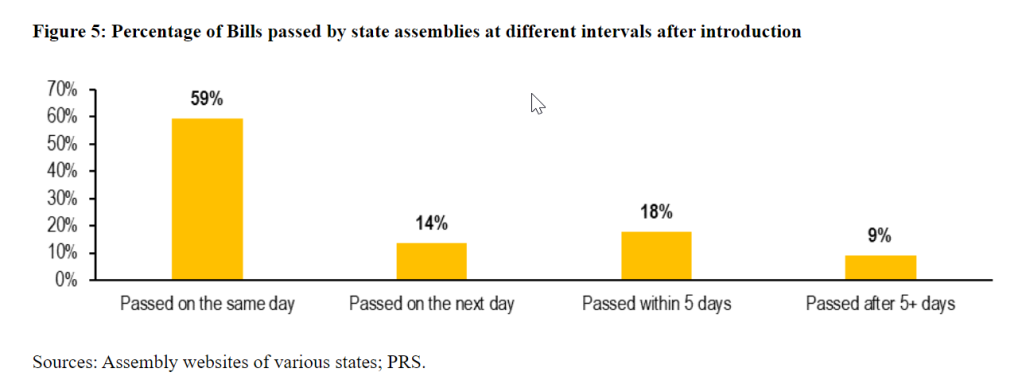First off, have you heard of PRS Legislative?
PRS tracks the functioning of the Indian Parliament and works with MPs from the Lok Sabha and Rajya Sabha across political parties and MLAs from various states. PRS provides a comprehensive and credible resource base to access Parliament-specific data, background information on Parliamentary and governance processes and analysis of key legislative and policy issues.
https://www.prsindia.org/aboutus/what-we-do
If you are a student of the social sciences in India (and who isn’t), this is a wonderful resource. It was started in the year 2005, and has provided stellar service to students of India for a very long time. See this, for example, if you are starting out in the study of public finances, or pretty much anything from this page.
But today’s post is about a specific report published by PRS recently: the Annual Review of State Laws 2020.
The Constitution of India provides for a legislature in each State and entrusts it with the responsibility to make laws for the state. They make laws related to subjects in the State List and the Concurrent List of the Seventh Schedule to the Constitution. These include subjects such as agriculture, health, education, and police. At present, there are 30 state legislatures in the country, including in the two union territories of Delhi and Puducherry.
https://prsindia.org/policy/analytical-reports/annual-review-of-state-laws-2020
State legislatures also determine the allocation of resources through their budgetary process. They collectively spend about 70% more than the centre. This implies that much of what affects citizens on a regular basis is decided at the level of the state. For a detailed discussion on the budgets of all states, please see our annual State of State Finances report.
This report focuses on the legislative work performed by states in the calendar year 2020. It is based on data compiled from state legislature websites and state gazettes. It covers 19 state legislatures, including the union territory of Delhi, which together account for 90% of the population of the country.
Tucked away under these paragraphs is a short one that will bring a wry smile to any Indian researcher’s face. It speaks about how information (and data) from India’s state legislature’s is hard to obtain. That, trust me, is putting it mildly.
Consider this:
The crowds that throng Mantralaya in Mumbai bear testimony to the fact that, apart from opacity in rules and processes which inhibit the common citizen getting her work done, there is still a lack of access to the right information and to the right persons in government who can and ought to meet the expectations of the common woman/man. The Maharashtra government website is woefully inadequate when it comes to informing the citizen about the procedures she should follow to get a particular work done. The website is focused more on putting forth not-so-useful information on departmental activities rather than on the steps needed to secure a particular benefit or license. Government departments need to focus on online processes for securing permissions, with human
https://puneinternationalcentre.org/wp-content/uploads/2019/10/Progressive-Maharashtra-Policy-Roadmap-2019-24-1.pdf
interface being kept to a minimum.
Please read the whole thing, pp 26-37 in this document, to get a sense of what needs to be done for a state like Maharashtra. Leave aside the question of the other states in the country!
But when a person who has definitely not left aside the question of the legislatures of the other states in the country takes note of the PRS’ annual review of state laws, it certainly behooves us to pay close and careful attention.
To return to PRS, the annual review has not been done in the best of times. After all, 2020 saw the first wave of the pandemic, though, in principle, meetings can also be virtual. As a benchmark, the Parliament met for 33 days in 2020. Pre-2020, these 19 states met for an average of 29 days a year. In 2020, they met for an average of 18 days. Before the pandemic, 29 days in a year? Had it not been for this report, I would have expected the number to be much higher.
https://indianexpress.com/article/opinion/columns/reforms-and-public-expenditures-lets-not-forget-to-scrutinise-states-7351650/
… and Bibek Debroy’s take on the report is not encouraging. Not, I hasten to add, a criticism of the report itself. Rather a criticism of the subject of the report: the state legislature and the job they’ve done this past year.

Read the whole report, please, but this chart is perhaps the most instructive:

3 out of every four bills that have been passed in state legislative assemblies were passed not more than one day after they were introduced. That, if you ask me, is too little debate.
There is a lot more at the link, of course – please do read the whole report. And if you’re looking for additional reading, this speech by Bibek Debroy would be a good place to start.
